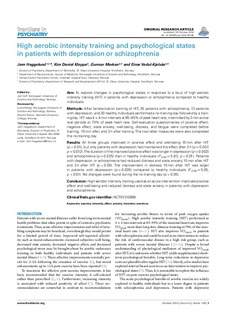High aerobic intensity training and psychological states in patients with depression or schizophrenia
Journal article, Peer reviewed
Permanent lenke
http://hdl.handle.net/11250/2357845Utgivelsesdato
2014Metadata
Vis full innførselSamlinger
Sammendrag
Aim: To explore changes in psychological states in response to a bout of high aerobic intensity training (HIT) in patients with depression or schizophrenia compared to healthy individuals.
Methods: After familiarization training of HIT, 20 patients with schizophrenia, 13 patients with depression, and 20 healthy individuals performed a no-training day followed by a training day. HIT was 4 × 4 min intervals at 85–95% of peak heart rate, intermitted by 3 min active rest periods at 70% of peak heart rate. Self-evaluation questionnaires of positive affect, negative affect, state anxiety, well-being, distress, and fatigue were completed before training, 15 min after, and 3 h after training. The two latter measures were also completed the no-training day.
Results: All three groups improved in positive affect and well-being 15 min after HIT (p < 0.01), but only patients with depression had maintained the effect after 3 h (p = 0.007, p = 0.012). The duration of the improved positive affect was longer in depression (p = 0.002) and schizophrenia (p = 0.025) than in healthy individuals (F2.50 = 5.83, p < 0.01). Patients with depression or schizophrenia had reduced distress and state anxiety 15 min after HIT and 3 h after HIT (p < 0.05). The improvement in distress 15 min after HIT was larger in patients with depression (p = 0.028) compared to healthy individuals (F2.50 = 5.05, p < 0.01). No changes were found during the no-training day (p > 0.05).
Conclusion: High aerobic intensity training used as an acute intervention improved positive affect and well-being and reduced distress and state anxiety in patients with depression and schizophrenia.
